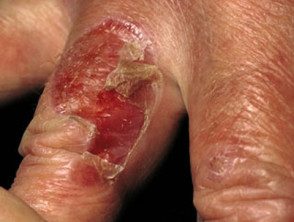What is epidermolysis bullosa?
Epidermolysis bullosa (EB) is the name given to a group of hereditary blistering diseases that are present from birth.
What is epidermolysis bullosa acquisita?
Epidermolysis bullosa acquisita (EBA) it's a weirdo autoimmune blistering disease in which tense subepithelial blisters appear at sites of trauma. Unlike EB, EBA is not inherited and usually presents in adult life.
EBA blisters tend to be located to areas that are easily injured, such as the hands, feet, knees, elbows, and buttocks. sometimes there is mucous membrane involvement with the formation of blisters in the mouth, nose and eyes.
Acquired epidermolysis bullosa

Acquired epidermolysis bullosa

Acquired epidermolysis bullosa

Acquired epidermolysis bullosa

Acquired epidermolysis bullosa

Acquired epidermolysis bullosa

Acquired epidermolysis bullosa
Who gets epidermolysis bullosa acquisita and why?
ABE usually occurs in the fourth and fifth decades of life. Men and women of all races can be affected.
Some patients with EBA have been reported to have other autoimmune diseases, most often Crohn's disease and systemic lupus erythematosus or health problems such as amyloidosis, multiple myeloma, and, rarely, carcinoma of the lung and lymphoma. Other patients only have a skin problem.
What is the cause of epidermolysis bullosa acquisita?
Researchers have detected tissue attached immunoglobulin (Ig)-G autoantibodies directed against NC1 type VII domain collagen (Col7) in affected patients. Type VII collagen is the main structural component of the anchor fibrils. They join the basement membrane of the epidermis to the underlying dermis. Loss of the anchoring fibrils leads to blister formation just below the epidermis within an area known as the lamina densa.
What are the clinical features of epidermolysis bullosa acquisita?
EBA has several different clinical presentations.
| EBA Classification | Clinical features |
|---|---|
|
Classic mechanobullous form of EBA |
|
|
Non-classical/non-mechanobullous form of EBA |
|
|
predominantly mucous membrane form of EBA |
|
|
Brunsting-Perry-type EBA |
|
|
IgA‐EBA |
|
How is epidermolysis bullosa acquisita diagnosed?
The following tests must be performed to establish a diagnosis of EBA.
-
Skin biopsy – this shows the presence of a blister under the epidermis (subepidermal bulla); A variable infiltrate of mixing inflammatory cells in the dermis; and milia cysts and scars in older lesions.
-
Direct immunofluorescence (DIF) from a skin biopsy: this shows statement of immunoglobulin (IgG more often than IgM or IgA) and C3 in a line along the dermal-epidermal junction. Blood vessels they are not involved
-
Indirect immunofluorescence (IIF) of serum – this reveals low-titer circulating IgG autoantibodies targeting the basement membrane.
Other tests to confirm the diagnosis they are only available in some academic centers. They include [2]:
- Skin biopsy for direct and indirect immunoelectrons. microscopy, DIF dentate pattern analysis, fluorescent overlay antigen mapping and DIF in salt split skin
- Blood tests to detect circulation. antibodies a Col7: immunoblot, enzymelinked immunosorbent assay (ELISA), more detailed IIF and immunoprecipitation.
The International Bullous Diseases Group (IBDG) has proposed by consensus clinical and diagnostic criteria for EBA [1,2]. If a bullous disease is clinically and histologically compatible with EBA, the diagnosis is confirmed if:
- Linear deposition of IgG and/or C3 along the basement membrane zone is demonstrated by direct immunofluorescence (DIF), and
- Autoantibodies against COL7 are detected in the patient's serum (via an enzyme-linked immunosorbent assay).
Which is the differential diagnosis for epidermolysis bullosa acquisita?
EBA can mimic other inflammatory blistering conditions, most often bullous pemphigoid and bullous systemic lupus erythematosus (which is also associated with anti-Col7 autoantibodies).
Compared to bullous pemphigoid, EBA [2]:
- It occurs in younger individuals, generally under 70 years of age.
- He has prominent involvement of the head and neck.
- involves mucous membranes
- The lesions heal with scarring and milia formation.
What is the treatment for epidermolysis bullosa acquisita?
the primary The goal of EBA treatment is to protect the skin and stop blistering, promote healing, and prevent complications.
Because EBA is considered an autoimmune disease, it is reasonable to use immunosuppressive agents to modify or reduce autoimmune responses and decrease autoantibody production. These may include:
- Azathioprine
- Dapsone
- Colchicine
- Corticosteroids
- Mycophenolate mofetil
- Gold
-
Intravenous immunoglobulin.
Due to the rarity of the disease, it is difficult to be sure which drug is the most effective.
Other important management strategies include:
- Treatment of any underlying disease.
- Consultation with other specialists such as a dentist and ophthalmologist.
- Avoid direct physical trauma to skin surfaces.
- Avoid hard or brittle foods or foods with high acid content in patients with oral compromise.
Which is the forecast?
ABE is a chronic inflammatory disease that has partial periods referrals and exacerbations. If treated and cared for properly, patients can expect to live a normal life. Problems that can arise include:
- Infection of open wounds and sores
- Severe scarring that can cause deformities and restriction of movement
- Periodontal disease
- Conjunctival scarring and blindness
- Medication side effects.
